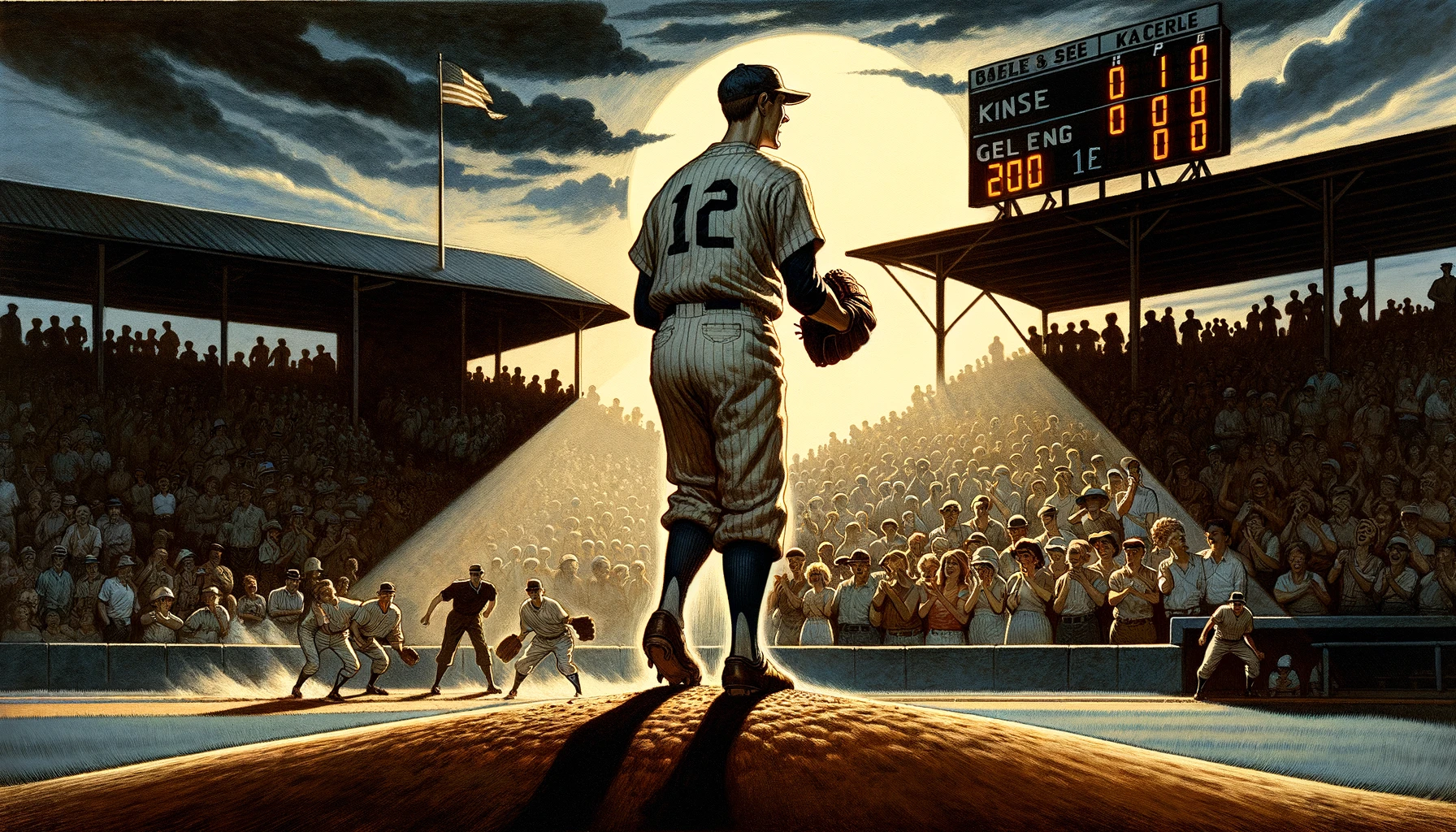What is a Save in Baseball?
In baseball, a save is a statistic awarded to a relief pitcher who finishes a game for the winning team under certain conditions.
To earn a save, the pitcher must enter the game with a lead of no more than three runs and pitch for at least one inning, or they must enter the game with the tying run in the on-deck circle, at the plate, or on base.
This rule keeps the game exciting by acknowledging pitchers who come in during tough situations and secure the win.
Understanding the save rule helps fans appreciate the strategic decisions managers make during the late innings of a game. You may read also What is a Quality Start in Baseball
Key Takeaways
- A save is awarded to a relief pitcher who successfully preserves a team’s lead under specific conditions outlined in Rule 9.19, which requires coming in late and performing under pressure.
- The save statistic is not only a measure of a pitcher’s performance but also plays a significant role during contract negotiations, reflecting the player’s value in high-stakes situations.
- While the save is a celebrated aspect of baseball history, it has been subject to criticism for potentially overvaluing a pitcher’s contribution in the final innings of a game.
- Understanding the difference between a save and a hold is crucial, as they represent distinct achievements for relief pitchers and involve different strategic considerations in the game.
- Familiarity with the criteria for a save is essential for fans and analysts, as it sheds light on the strategic deployment of pitchers and the nuances of the game’s late stages.
The Official Rulebook on Saves

Defining a Save According to Rule 9.19
Rule 9.19 in the official baseball rulebook meticulously defines what constitutes a save. A save is awarded to a relief pitcher who fulfills certain stringent conditions while preserving a team’s lead.
These conditions are designed to quantify the pitcher’s effectiveness in high-pressure situations toward the end of the game.
The criteria for a save include:
- Entering the game with a lead of no more than three runs and maintaining that lead until the end.
- Recording at least the final out, which ensures the team’s victory.
- Pitching for at least three innings, provided the lead is preserved throughout their appearance.
It’s important to note that the pitcher credited with a save cannot also be the winning pitcher.
The distinction between securing a win and saving a game is a fundamental aspect of the rule, emphasizing the specialized role of the closer in baseball. You may read the guide on What is a Bullpen in Baseball
The Role of Saves in Contract Negotiations
In the high-stakes world of baseball, saves are a currency for closers in contract negotiations.
Teams place a premium on pitchers who consistently secure the final outs winning games, recognizing the rarity and value of such talent.
High save totals often translate into tangible benefits for players:
- Increased Salary: A track record of saves can significantly boost a pitcher’s earnings.
- Better Contract Terms: Star closers with impressive save statistics are more likely to secure long-term contracts.
- Endorsement Opportunities: Being a high-profile closer can open doors to lucrative endorsement deals.
As a result, the save statistic becomes a pivotal factor during contract discussions, influencing the financial and professional future of relief pitchers.
Understanding the Conditions for a Save
To secure a save, a pitcher must navigate a series of specific conditions with precision.
The pitcher must take the mound with a lead of no more than three runs and pitch at least one inning, or they must enter the game with the potential tying first run on base, at bat, or on deck.
These criteria ensure that the pitcher’s performance is measured in a high-pressure situation, reflecting their ability to maintain the team’s lead when it matters most.
The conditions for a save are not just about the numbers; they encapsulate the essence of a clutch performance.
Here are the key points to remember:
- The pitcher must enter the game under one of the defined scenarios that qualify for a save.
- They must finish the game without surrendering the lead.
- The save is awarded regardless of the game’s final score, as long as the lead is preserved.
Understanding these conditions is crucial for fans, as it highlights the pitcher’s skill and mental fortitude in the game’s most tense moments.
Read Also: What is an Infield Fly Rule in Baseball
Controversies and Debates: The Save’s Significance

The Impact of the Save on Pitchers’ Value
The save has become a pivotal statistic in baseball, particularly for relief pitchers.
Its introduction in the late 1960s marked a new era for evaluating pitchers’ performances, especially those specializing in closing games.
A save not only reflects a pitcher’s ability to maintain a lead under pressure but also serves as a badge of honor, showcasing their reliability in high-stakes situations.
The value of a pitcher in the eyes of teams and fans can be significantly influenced by their save statistics.
Here are some key points to consider:
- Career longevity: A consistent ability to earn saves can lead to a more enduring and lucrative career for a pitcher.
- Contract negotiations: Save stats play a key role during contract talks, often dictating a pitcher’s market value.
- Team dynamics: A closer’s success in securing saves contributes to team morale and can define the relationship between starting pitchers and closers.
However, the emphasis on saves has sparked debates and criticism. Critics argue that the rule may lead to:
- Overvaluing late-game pitching, potentially overshadowing the contributions of starting pitchers and middle relievers.
- Statistical inflation, as relievers might enter games with a comfortable lead, thus not accurately reflecting high-pressure performance.
- Impact on strategy, with managers possibly making suboptimal decisions by reserving their best relievers exclusively for save situations.
Analyzing the Criticism of the Save Rule
The Save rule, integral to baseball’s late-game dynamics, is not without its detractors.
Critics argue that it disproportionately highlights the role of a closer over other pitchers, potentially distorting their perceived value.
The rule’s emphasis on the final innings is seen as an overvaluation of late-game pitching, which can lead to several issues:
- Overvaluing late-game pitching can overshadow the contributions of starting pitchers and middle relievers.
- There’s a risk of statistical inflation, as relievers might enter games with a comfortable lead, thus not facing high-pressure situations.
- The rule may influence managerial decisions, prompting the use of top relievers exclusively in save situations, which could be strategically limiting.
In response to these criticisms, some baseball enthusiasts and analysts have proposed alternatives to the Save rule.
These suggestions aim to create a more comprehensive measure of a pitcher’s effectiveness and their true impact on the game’s outcome.
The Save Statistic in the Context of Baseball History
The save has become a pivotal part of baseball’s statistical framework, especially since its official adoption in the late 1960s.
Initially, the concept of a save was recognized informally, with the term itself gaining prominence as relief pitchers began to specialize in maintaining leads late in the game.
- Rule inception: 1960 by baseball writer Jerome Holtzman
- Adoption: Major League Baseball in 1969
- Amendments: Multiple changes to criteria over time
This evolution reflects the changing dynamics of the sport and the increasing value placed on strategic pitching.
As the role of the closer became more defined, the save statistic grew in importance, influencing not just game outcomes but also players’ careers and contract negotiations.
Despite its significance, the save rule has not been without controversy, with some critics arguing that it overemphasizes the final innings and can skew a pitcher’s perceived value.
Read Also: What is Rosin in Baseball
Criteria for Awarding a Save

The Three-Run Lead Scenario
One of the most common situations for a relief pitcher to earn a save is when they enter the game with a three-run lead.
Under this scenario, the pitcher must meet several criteria to be awarded a save:
- The pitcher arrives with no more than a three-run lead and maintains that edge till the end.
- Recording at least the final out is a must, ensuring the team’s victory is sealed.
- If their time on the mound stretches three innings or more, the save is in sight, but only if the lead remains intact.
The pitcher mustn’t be the winning pitcher, as the roles of hero and savior are distinct in baseball.
This distinction emphasizes the specialized role of the closer, who is often brought in during high-pressure situations to secure the win.
The ability to handle the pressure, especially with base traffic, and to match up against upcoming hitters is what separates a good closer from the rest. You may read the guide on What is a Cycle in Baseball
The Closer’s Role in Securing Victory
In the high-stakes environment of the ninth inning, the closer emerges as the team’s safeguard, entrusted with the crucial task of preserving the lead and clinching the game.
This specialist pitcher is characterized by a remarkable ability to remain composed under intense pressure, as such pitcher is often facing the heart of the opponent’s lineup.
The closer’s impact extends beyond the mound, influencing team morale and the strategic fabric of the game.
Here are some key points about the closer’s role:
- Their success in securing saves can galvanize a team, instilling a culture of confidence and expectation of victory.
- The decision to deploy a closer is a tactical one, requiring a deep understanding of the game’s flow and the opposing team’s threats.
- A harmonious relationship with starting pitchers is essential, as the game’s outcome often hinges on a seamless transition from the starter’s groundwork to the closer’s finishing touch.
Distinguishing Between a Save and a Win
While both a save and a win are marks of a pitcher’s success, they represent different more than one pitcher, achievements on the field.
A win is credited to the pitcher who was in the game when their team took the lead for the last time, provided they meet certain criteria, whereas a save is about finishing pitcher preserving that lead until the game concludes.
- A win is awarded to a starting or relief pitcher who fulfills specific conditions regarding innings pitched and the team’s lead during their time on the mound.
- A save, on the other hand, is reserved for a relief pitcher who enters the game under certain high-pressure conditions and maintains the team’s lead.
Understanding the distinction between these two statistics is crucial for fans and players alike, as it reflects the different roles pitchers play in securing a team’s victory.
While the starter aims to establish a lead, the final pitcher and the closer’s job is to ensure that the lead remains intact until the final out.
Read Also: What is Arbitration in Baseball
Key Differences: Hold vs. Save

Understanding the Hold Statistic
In the landscape of baseball statistics, the hold is a measure of a relief pitcher’s effectiveness in a specific scenario.
A hold is recorded when a relief pitcher enters the game in a save situation, maintains the lead, and exits without finishing the game.
This does not result in a save but rather highlights the pitcher’s ability to sustain the team’s momentum.
The hold statistic is indicative of a pitcher’s reliability, with higher hold totals suggesting a pitcher’s dependability in preserving leads.
Conversely, lower hold totals may point to struggles in high-pressure situations or inconsistent performance.
It’s important to note that:
- Hold numbers can indicate a pitcher’s consistency.
- They should be analyzed in conjunction with other stats for a comprehensive view of performance.
- The hold is a valuable metric for understanding the middle innings of a game.
Despite its utility, the hold statistic is not without controversy. It has sparked debate among baseball enthusiasts and analysts, with some questioning its significance and impact on the game’s strategic elements.
Comparing the Roles of Setup Pitchers and Closers
Setup pitchers and closers serve distinct functions in the bullpen, each critical to a team’s success.
Setup pitchers are the bridge between the starting pitcher and the closer, often a middle reliever pitching in the 7th or 8th innings.
They work to maintain the lead or keep the tie game well within reach, setting the stage for the closer to come in.
Closers, on the other hand, are the last line of defense. They are typically reserved for the final inning, entering the game when the stakes are highest and the pressure is on.
A closer’s job is to seal the victory, often facing the heart of the opponent’s lineup. Their workload is usually limited to 1 inning or less. But it’s a high-stakes situation that demands mental toughness and the ability to throw high-velocity strikes under pressure.
- Lead Status: A closer enters with a narrow lead.
- Inning: Usually the ninth, or sometimes the eighth in high-stakes situations.
- Hitter Matchups: Closers are matched against hitters where they have the advantage.
- Base Traffic: The presence of runners increases the pressure on the closer.
Strategic Use of Holds and Saves in Games
In the strategic landscape of baseball, holds and saves are pivotal in shaping the outcome of a game.
Managers often deploy their bullpen to maximize the chances of maintaining a lead or securing a win, using holds and saves as key tools.
- A hold is credited to a relief pitcher who enters the game in a save situation and maintains the lead but does not finish the game. Multiple pitchers can earn holds in a single game, creating a bridge to the closer.
- A save is awarded to the pitcher who finishes the game under specific conditions, ensuring the team’s victory. Unlike holds, only one save can be granted per game, and it is an official statistic.
Understanding when to pursue a hold or a save opportunity can be the difference between a win and a loss.
Managers must consider the game’s context, the pitchers’ strengths, and the opposing lineup when deciding which pitcher to use in these high-stakes situations.
See Also: What is a Hold in Baseball
Conclusion
In baseball, the save is a key stat that shows a pitcher’s skill in holding a lead in the last innings and clinching the win for their team. Defined in the official rulebook, the save often sparks lively discussions among fans and experts.
Despite some criticisms that it might give too much credit to a pitcher’s late-game actions, the tension and thrill of a save situation can’t be ignored. It adds excitement to the ballpark.
By understanding what a save is, the conditions needed for a pitcher to earn it, and its role in baseball history, fans can get a deeper appreciation of the sport.







